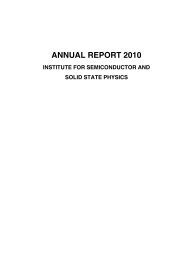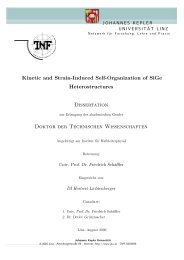Annual Report 2008 - Institut für Halbleiter - JKU
Annual Report 2008 - Institut für Halbleiter - JKU
Annual Report 2008 - Institut für Halbleiter - JKU
Create successful ePaper yourself
Turn your PDF publications into a flip-book with our unique Google optimized e-Paper software.
6 Research Overview Part A: Semiconductor Physics Group<br />
Research Overview<br />
Nanostructures<br />
Research at the institute is focused on investigation and fabrication of semiconductor heteroand<br />
nanostructures and it is a major part of the center of “Nanoscience and Technology” of<br />
the Johannes Kepler University Linz. The research encompasses all aspects of semiconductor<br />
nanostructures, ranging from nanofabrication, fundamental investigations and modeling of<br />
physical properties up to the realization of novel nanostructure devices for spintronic and infrared<br />
optoelectronic applications. Nanostructures are fabricated using advanced lithography<br />
and processing techniques including electron beam lithography, holographic lithography, as<br />
well as self-assembled growth of quantum dots using molecular beam epitaxy. For these purposes,<br />
a class 100 clean room facility with all necessary processing equipment is run at the<br />
institute. The objective of nanofabrication is to produce defect free structures in the sub 50 nm<br />
range with good control of shapes and compositions, sharp heterointerfaces and excellent optical<br />
and electronic properties. A particular emphasis is on the development of site-control<br />
techniques for positioning of self-assembled nanostructures.<br />
The research activities are embedded in several large research initiatives and project clusters<br />
such as the IRON special research program, the NSI Nanostructured Surface and Interface<br />
project cluster, as well as the SANDiE European network of excellence and several other EU<br />
funded research projects, more details are given in the other parts of the annual report.<br />
Physical Properties<br />
The fundamental structural, electronic, optical and magnetic properties of nanostructures are<br />
studied using a wide range of techniques. These range from advanced x-ray scattering techniques<br />
using advanced laboratory as well as synchrotron radiation sources, high-resolution<br />
electron microscopy, scanning force and scanning tunneling microscopy, optical spectroscopy<br />
as well as low temperature magnetotransport investigations. An important focus of research is<br />
to correlate the actual electronic properties of nanostructures with the structural properties determined<br />
by the fabrication processes, taking advantage of the complementary information<br />
gained by the wide range of techniques and modeling tools. A strong emphasis is on infrared<br />
spectroscopy of interband and intersubband electronic transitions in SiGe and narrow band<br />
gap semiconductors heterostructures, as well as on ballistic and quantum transport studies of<br />
SiGe and III-V hetero- and nanostructures in the milli-Kelvin temperature regime. In addition,<br />
the magnetic properties of magnetic semiconductor hetero- and nanostructures are investigated<br />
and novel tools for nanostructure investigations based on synchrotron light sources are<br />
developed.<br />
Devices<br />
Several research projects are devoted to the fabrication of hetero- and nanostructure devices,<br />
for mid-infrared intersubband and interband detectors, quantum cascade structures, midinfrared<br />
vertical cavity surface emitting lasers, resonant cavity detectors as well as transport<br />
devices such as quantum dot and single electron transistors. In addition, novel spintronic devices<br />
that take advantage of the spin degree of freedom in order to produce new functionalities<br />
are developed.











